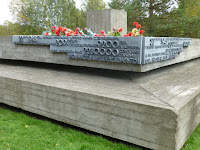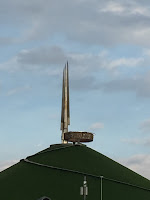
Yesterday I took a half-day tour to visit the Khatyn Memorial Site and the Mound of Glory.
Хаты́нь was a village about 50 km (31 miles) from
Minsk. The small village had 26 houses and only 156 inhabitants.

On 22 March 1943, Soviet partisans attacked a German convoy just 6 km from Khatyn. Four were killed including the commanding officer Hans Wöllke, who had won a gold medal for shot put at the 1936 Berlin Olympics. He was also an acquaintance of Adolf Hitler.

As retribution, all of the residents were taken from their homes and put in a shed which was set on fire. Those that tried to escape the burning building were killed by machine gun fire. The village was looted and then burned to the ground. 147 people, including 75 children under the age of 16, were murdered. Only five children and one adult survived.
 |
| The bells show where the houses were. |
During the war it was a Nazi tactic to punish an entire village as punishment for collaboration with partisans. The same thing happened to
Lidice in Czechland.

The
Unsubdued Man depicts Yuzif Kaminsky, the only adult who survived, holding his dead son Adam.

Part of the memorial is the "cemetery of villages". Each of the 185 tombs represents a Belarusian village that was burned to the ground, along with its population, during the war.

After Khatyn we drove to the Mound of Glory.
Курган Славы is about 21 km (13 miles) from Minsk on the Moscow Highway.

The monument was established in 1969 to commemorate the 25th anniversary of Operation Bagration.

In 1944, Operation Bagration was a major victory for the Soviet Union as it completely ruptured the German front line.


The monument is a ring with four large bayonets that symbolises the fighting brotherhood of soldiers on four fronts.
There are a number of tanks on display at the base of the hill.


























No comments:
Post a Comment